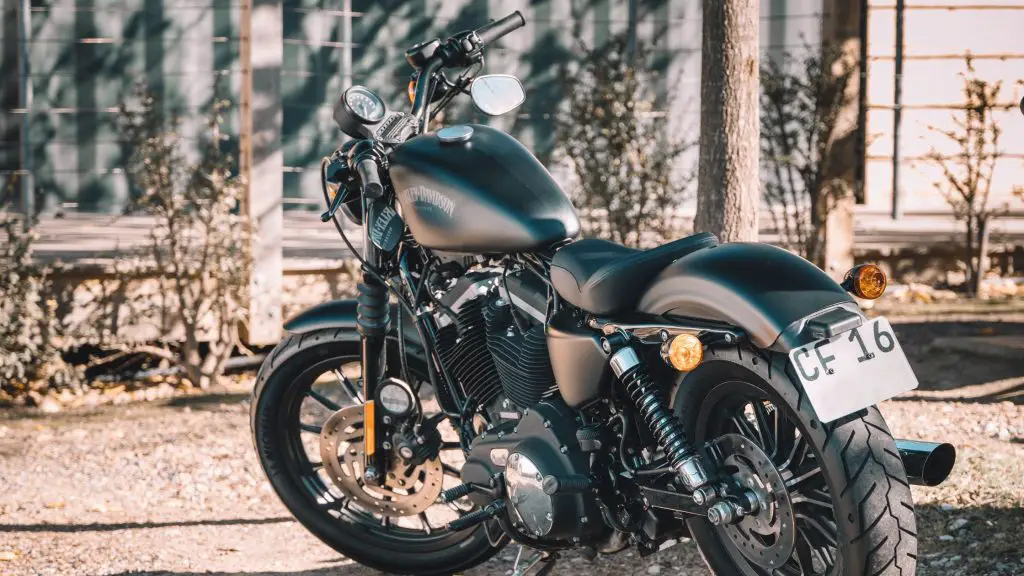Whether you ride a Harley Davidson as a hobby or for work, you know how important it is to keep your bike running smoothly. A smooth idle is essential for a comfortable and enjoyable ride, and adjusting the idle on your fuel-injected Harley Davidson is a simple way to ensure that your engine is running at its best.
In this blog post, we will walk you through the process of adjusting the idle on your fuel-injected Harley Davidson step-by-step. By following these simple instructions, you can ensure that your Harley Davidson is idling smoothly and efficiently, enhancing your riding experience and helping to extend the life of your engine.

Why Adjusting Idle on a Fuel-Injected Harley Davidson is Important?
Improving Engine Performance
The idle speed is the revolution per minute (RPM) at which an engine runs when it is idling. A properly adjusted idle speed will ensure that the engine is running smoothly and efficiently. If the idle speed is too high, the engine will be wasting fuel and emitting more pollutants. If the idle speed is too low, the engine may stall or run rough. By adjusting the idle speed, you can ensure that your engine is running at its optimal performance level. This will result in better fuel economy, reduced emissions, and a smoother, more enjoyable ride.
Improving Fuel Efficiency
Fuel efficiency is the amount of fuel that an engine uses to travel a certain distance. A properly adjusted idle speed can help to improve fuel efficiency by ensuring that the engine is running at its most efficient RPM. When the idle speed is too high, the engine is wasting fuel. When the idle speed is too low, the engine may stall or run rough, which can also waste fuel. Nonetheless, the importance of adjusting the idle on a fuel-injected Harley Davidson lies within this uncertainty.
By adjusting the idle speed, you can help to improve your motorcycle’s fuel efficiency and save money on fuel costs.
Reducing Engine Vibrations
Engine vibrations can be caused by a number of factors, including a poorly adjusted idle speed. When the idle speed is too high, the engine is running more aggressively, which can cause more vibrations. When the idle speed is too low, the engine may not be running smoothly, which can also cause vibrations.
By adjusting the idle speed, you can help to reduce engine vibrations and make your motorcycle ride smoother and more enjoyable. If you are not comfortable adjusting the idle speed yourself, you can take your motorcycle to a qualified mechanic.
Improved Engine Performance
Optimizing the air-fuel mixture is crucial for improved engine performance. By carefully adjusting the fuel injection system, you can achieve better combustion and maximize power output. Taking just 15 minutes to make these adjustments can significantly enhance your motorcycle’s overall performance.

Ensuring smooth combustion is another key aspect of improving engine performance. By fine-tuning ignition timing and fuel delivery, you can eliminate misfires and improve throttle response. This not only enhances power but also prevents engine stalls during acceleration or deceleration. Adjusting these settings takes minimal time but greatly improves your riding experience.
Enhanced Fuel Efficiency
Achieving optimal idle RPM is crucial for enhancing fuel efficiency. By adjusting the idle speed, you can ensure that your fuel-injected Harley Davidson consumes fuel at an optimal rate when idling. Reducing unnecessary fuel consumption is another key aspect in improving mileage per gallon. By minimizing idling time and avoiding excessive revving, you can significantly reduce fuel wastage during your rides.
Adjusting idle speed– is the process of setting the RPM (revolutions per minute) at which an engine runs when it is idling. This is done by adjusting the throttle plate or idle air bypass screw.
Minimizing idling time– is the practice of reducing the amount of time that an engine is running when it is not in use. This can be done by turning off the engine when it is not needed, such as when waiting in line at a drive-thru or when parked in a loading zone.
Avoiding excessive revving– is the practice of running an engine at a high RPM for an extended period of time.
Reduced Engine Vibrations
Balancing the engine’s rotational forces is crucial for reducing engine vibrations. By ensuring that the rotating components are properly aligned and weighted, you can minimize unwanted tremors and enhance overall riding comfort. Additionally, minimizing internal friction and wear through proper lubrication and maintenance will further contribute to smoother engine operation and reduced vibration levels.
Tools and Materials Needed
Screwdriver: A Phillips head screwdriver is necessary to loosen and tighten the screws on your Harley Davidson’s idle adjustment. Make sure you have the appropriate size for your specific model.
Tachometer: A tachometer is a crucial tool for accurately adjusting the idle speed of your fuel-injected Harley Davidson. It measures engine revolutions per minute (RPM) and helps ensure that you achieve the desired idle RPM.
Owner’s Manual: The owner’s manual is an invaluable resource that provides detailed instructions on how to adjust the idle on your specific model of fuel-injected Harley Davidson. Be sure to consult it for any additional tools or materials required, as well as step-by-step guidance tailored to your motorcycle.
There are more materials and tools that can be used, but the above-mentioned are the most important and needed to adjust the idle on fuel-injected Harley Davidson.
Step 1: Preparing Your Motorcycle
Park your motorcycle on a flat surface to ensure stability and safety during the adjustment process. Turn off the engine and allow it to cool down before beginning any work. Make sure you have all the necessary tools handy for adjusting the idle of your fuel-injected Harley Davidson.
Step 2: Locating the Idle Adjustment Screw
To locate the idle adjustment screw on your fuel-injected Harley Davidson, consult your owner’s manual to find its specific location. The manual will provide detailed instructions and diagrams to help you easily identify the screw. Additionally, take note of any components that may need to be removed or adjusted for better access to the idle adjustment screw. This may include fairings, air cleaners, or other parts that could obstruct your reach. By following these steps, you will be ready to make precise adjustments to your motorcycle’s idle speed.
Step 3: Adjusting the Idle Speed
Using a Tachometer: A tachometer is a useful tool for adjusting the idle speed on your fuel-injected Harley Davidson. Start by attaching the tachometer to your motorcycle according to the manufacturer’s instructions. Then, start your bike and let it warm up to its normal operating temperature. While idling, use the tachometer to adjust the idle speed within the recommended range.
Using Sound and Feel: If you don’t have access to a tachometer, you can still adjust the idle speed using sound and feel. Start by starting your motorcycle and letting it warm up as usual. Listen carefully for any irregular or rough sounds coming from your engine while it’s idling. Additionally, pay attention to how smoothly or roughly your bike vibrates at idle. Use this information as a guide when making small adjustments until you achieve a smooth and stable idle speed that feels right for you.
Using a Tachometer
Using a Tachometer
- Step 1: Preparing the Tachometer
- – Ensure the tachometer is compatible with your fuel-injected Harley Davidson.
- – Familiarize yourself with the tachometer’s functions and features.
- Step 2: Locating the Idle Speed Control
- – Refer to your motorcycle’s manual to locate the idle speed control.
- – Take note of any specific instructions or precautions provided in the manual.
- Step 3: Connecting the Tachometer to the fuel-injected Harley Davidson
- – Follow manufacturer instructions to securely connect the tachometer to your motorcycle.
- Verify the proper connection by checking for accurate RPM readings on the tachometer display.
Using Sound and Feel
Step 1: Starting the Motorcycle
To adjust the idle on your fuel-injected Harley Davidson, start by turning on the ignition and waiting for all warning lights to turn off. Then, press and hold the starter button until the engine starts.
Step 2: Listening for Proper Idle Sound
Once your motorcycle is running, listen closely to the sound it makes at idle. A smooth and even rumble indicates a proper idle speed, while erratic or uneven sounds may suggest an adjustment is needed.
Step 3: Adjusting Idle Speed by Turning the Screws
To fine-tune your idle speed, locate the idling screws on your motorcycle’s throttle body. Use a screwdriver to gently turn these screws clockwise to increase or counterclockwise to decrease the RPMs until you achieve a steady and balanced sound.
Remember that adjusting idle speed requires patience and precision. Take time to make small adjustments incrementally while paying attention to how each change affects your motorcycle’s sound and feel.
Step 4: Verifying and Fine-Tuning the Idle
After making adjustments to the idle on your fuel-injected Harley Davidson, it is important to listen for any changes in the engine performance. Pay close attention to any irregular sounds or vibrations that may indicate a problem. If you are not satisfied with the initial adjustment, don’t hesitate to repeat the process until you achieve the desired idle speed. By carefully verifying and fine-tuning the idle, you can enhance your riding experience on your fuel-injected Harley Davidson motorcycle.
Here are some specific things to listen for:
- Rough idle. If the engine is idling rough, this could be a sign that the idle speed is too high or too low.
- Engine vibrations. If the engine is vibrating more than usual, this could also be a sign that the idle speed is not correct.
- Excessive noise. If the engine is making more noise than usual, this could be a sign that there is a problem with the idle air control system.
If you hear any of these things, it is important to adjust the idle speed until the engine is running smoothly and quietly. You may need to repeat the adjustment process a few times to get it just right.
By carefully listening for changes in the engine performance and adjusting the idle speed as needed, you can ensure that your fuel-injected Harley Davidson is running smoothly and efficiently. This will improve your riding experience and help to extend the life of your engine.

Listening for Changes
Using a tachometer to monitor the RPM, you can accurately adjust the idle on your fuel-injected Harley Davidson. This ensures optimal performance and smooth operation. Additionally, it is important to listen for any unusual engine sounds or vibrations, as these could indicate potential issues that need attention. By being attentive and proactive in listening for changes, you can address any problems early on and prevent further damage to your motorcycle.
Repeating the Process if Necessary
Checking for consistency in idle speed after adjustments is crucial to ensure that the modifications made have been effective. To do this, start the motorcycle and allow it to reach its normal operating temperature. Use a tachometer to measure the idle speed and compare it with the manufacturer’s recommended range. If the idle speed falls within this range, then further modifications may not be necessary. However, if the idle is still not satisfactory, additional adjustments can be made.
- Re-check idle speed using a tachometer
- Compare the measured value with the manufacturer’s recommended range
- If within range: No further modifications are needed
- If outside of range: Make additional adjustments as required
Step 5: Cleaning Up
Reinstall any components that were removed earlier, making sure they are properly secured and aligned. Wipe down any surfaces that may have collected dirt or grease using a clean cloth or mild detergent. Double-check all connections before starting up your motorcycle again to ensure everything is properly connected and functioning correctly.
How do I know if I need to adjust the idle on my fuel-injected Harley Davidson?
If you’re a proud owner of a fuel-injected Harley Davidson, you may be wondering how to determine if you need to adjust the idle on your motorcycle. While fuel-injected engines are designed to automatically adjust the idle speed based on various factors, there are instances where manual adjustment may be necessary. So, how do you know if it’s time to tweak the idle on your Fuel-injected Harley Davidson? Let’s explore some key indicators.
1. Engine Stalling: One of the most obvious signs that your idle needs adjustment is if your engine stalls frequently, especially when idling at a stoplight or in slow-moving traffic. This may indicate that the idle speed is set too low, causing the engine to struggle to maintain a steady idle.
2. High Idle Speed: On the other hand, if you notice that your idle speed is consistently higher than normal, it may be a sign that the idle needs adjustment as well. A higher-than-usual idle can lead to increased fuel consumption and unnecessary wear on engine components.
3. Rough Idle: Does your motorcycle vibrate excessively or have a rough, inconsistent idle? This could be an indication that the idle adjustment is off. A smooth, steady idle is not only crucial for engine performance but also for rider comfort.
4. Poor Fuel Efficiency: If you’ve noticed a decrease in fuel efficiency, it’s worth checking the idle adjustment. An improperly adjusted idle can cause the engine to run rich or lean, resulting in increased fuel consumption and potentially damaging the engine over time.
What potential problems should I be aware of when adjusting the idle on a fuel-injected Harley Davidson?
Adjusting the idle on a fuel-injected Harley Davidson can have its challenges and potential problems that you should be aware of. While it may seem like a simple task, improper adjustments can lead to issues that may affect the performance and overall reliability of your motorcycle. Here are a few potential problems you should take into consideration when adjusting the idle on a fuel-injected Harley Davidson:
1. Warranty concerns: Fuel-injected Harley Davidson motorcycles come with a warranty that covers various components of the bike, including the fuel injection system. Any modifications or adjustments made to the idle could potentially void the warranty. It is crucial to consult your owner’s manual or contact your authorized Harley Davidson dealer to ensure that adjusting the idle won’t have any adverse effects on your warranty.
2. Incorrect idle speed: Setting the idle speed too low can result in stalling and engine cut-outs, especially when the bike is idling at a stop sign or traffic light. On the other hand, if the idle speed is set too high, it can cause excessive engine wear, increased fuel consumption, and even potential damage to other engine components. It is essential to find the correct idle speed, which is typically specified by the manufacturer, to maintain optimal performance.
3. Fuel efficiency and emissions: Fuel injection systems are designed to deliver the precise amount of fuel required for efficient combustion. Adjusting the idle incorrectly can disrupt this balance, leading to decreased fuel efficiency and increased emissions. This not only impacts your wallet but also contributes to environmental pollution. It is recommended to refer to emission standards.

Conclusion
In conclusion, adjusting the idle on your fuel-injected Harley Davidson can greatly improve the performance and overall rideability of your motorcycle. By following this step-by-step guide and using the necessary tools and materials, you can easily locate and adjust the idle adjustment screw. Remember to always refer to your motorcycle’s manual for specific instructions and consult with a professional if you are unsure about any steps or procedures. Taking the time to properly adjust your idle will ensure a smoother running engine and a more enjoyable riding experience.
Overall, adjusting the idle on your fuel-injected Harley Davidson is a straightforward process that can be easily accomplished with some basic knowledge and preparation. By taking care of this important maintenance task, you’ll be able to enhance both the performance and longevity of your motorcycle while also enjoying a smoother ride. Don’t forget to regularly clean up after making adjustments as part of proper upkeep for optimal results.
